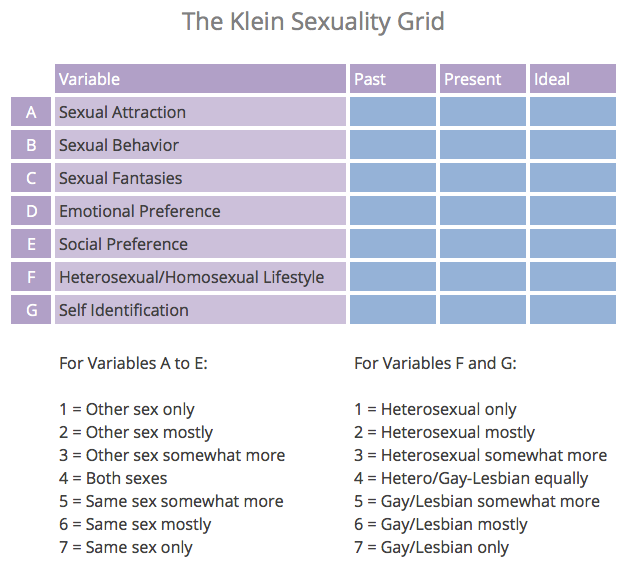The Klein Sexual Orientation Grid
The Klein Sexual Orientation Grid (or KSOG) is a system for describing a person's sexual proclivities in a way more detailed and informative than previous methods. It was introduced by Dr. Fritz Klein (1932-2006) in his book The Bisexual Option.
The Klein Sexual Orientation Grid is shown in the table below. For each person, it sets out the seven component variables of sexual orientation, listed as A through G down the left side. The three columns indicate three different points at which sexual orientation is assessed: the person's past, their present, and their ideal. The person then receives a rating from 1 to 7 for each of the 21 resulting combinations, one rating for each empty box in the chart below. The meanings of the ratings are indicated just below the grid itself.
Definitions helpful in using the Klein scale:
Past: Your life up to 12 months ago.
Present: The most recent 12 months
Ideal: What do you think you would eventually like?
The Variables:
Sexual Attraction: To whom are you sexually attracted?
Sexual Behavior: With whom have you actually had sex?
Sexual Fantasies: Whom are your sexual fantasies about? (They may occur during masturbation, daydreaming, as part of real life, or purely in your imagination.)
Emotional Preference: Emotions influence, if not define, the actual physical act of love. Do you love and like only members of the same sex, only members of the other sex, or members of both sexes?
Social Preference: Social preference is closely allied with but often different from emotional preference. With members of which sex do you socialize?
Lifestyle Preference: What is the sexual identity of the people with whom you socialize?
Sexual Identity: How do you think of yourself?
Political Identity: Some people describe their relationship to the rest of society differently than their personal sexual identity. For instance, a woman may have a heterosexualsexual identity, but a lesbian political identity. How do you think of yourself politically?
Note that the Klein Grid takes into consideration the fact that many people change their orientation over time. Where a person is today is not necessarily where she or he was in the past -- or, for that matter, where he or she will be or would like to be in the future. The concept of sexual orientation as an ongoing dynamic process is necessary if we are to understand a person's orientation properly in its entirety. A more detailed explanation is found in Chapter 2 of Dr. Klein's book The Bisexual Option.
Please note that although it is entirely possible for an individual to utilize the Klein Grid for the purposes of better determining self identification through a process of self assessment, if you are in the process of coming out as bisexual, the best option is to seek the guidance of a professional therapist who understands bisexuality.


